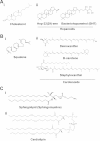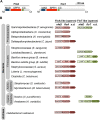Exploring the existence of lipid rafts in bacteria
- PMID: 25652542
- PMCID: PMC4342107
- DOI: 10.1128/MMBR.00036-14
Exploring the existence of lipid rafts in bacteria
Abstract
An interesting concept in the organization of cellular membranes is the proposed existence of lipid rafts. Membranes of eukaryotic cells organize signal transduction proteins into membrane rafts or lipid rafts that are enriched in particular lipids such as cholesterol and are important for the correct functionality of diverse cellular processes. The assembly of lipid rafts in eukaryotes has been considered a fundamental step during the evolution of cellular complexity, suggesting that bacteria and archaea were organisms too simple to require such a sophisticated organization of their cellular membranes. However, it was recently discovered that bacteria organize many signal transduction, protein secretion, and transport processes in functional membrane microdomains, which are equivalent to the lipid rafts of eukaryotic cells. This review contains the most significant advances during the last 4 years in understanding the structural and biological role of lipid rafts in bacteria. Furthermore, this review shows a detailed description of a number of molecular and genetic approaches related to the discovery of bacterial lipid rafts as well as an overview of the group of tentative lipid-protein and protein-protein interactions that give consistency to these sophisticated signaling platforms. Additional data suggesting that lipid rafts are widely distributed in bacteria are presented in this review. Therefore, we discuss the available techniques and optimized protocols for the purification and analysis of raft-associated proteins in various bacterial species to aid in the study of bacterial lipid rafts in other laboratories that could be interested in this topic. Overall, the discovery of lipid rafts in bacteria reveals a new level of sophistication in signal transduction and membrane organization that was unexpected for bacteria and shows that bacteria are more complex than previously appreciated.
Copyright © 2015, American Society for Microbiology. All Rights Reserved.
Figures







Similar articles
-
Molecular composition of functional microdomains in bacterial membranes.Chem Phys Lipids. 2015 Nov;192:3-11. doi: 10.1016/j.chemphyslip.2015.08.015. Epub 2015 Aug 28. Chem Phys Lipids. 2015. PMID: 26320704 Review.
-
Functional microdomains in bacterial membranes.Genes Dev. 2010 Sep 1;24(17):1893-902. doi: 10.1101/gad.1945010. Epub 2010 Aug 16. Genes Dev. 2010. PMID: 20713508 Free PMC article.
-
Functional Membrane Microdomains Organize Signaling Networks in Bacteria.J Membr Biol. 2017 Aug;250(4):367-378. doi: 10.1007/s00232-016-9923-0. Epub 2016 Aug 26. J Membr Biol. 2017. PMID: 27566471 Review.
-
Overproduction of flotillin influences cell differentiation and shape in Bacillus subtilis.mBio. 2013 Nov 12;4(6):e00719-13. doi: 10.1128/mBio.00719-13. mBio. 2013. PMID: 24222488 Free PMC article.
-
Exploring functional membrane microdomains in bacteria: an overview.Curr Opin Microbiol. 2017 Apr;36:76-84. doi: 10.1016/j.mib.2017.02.001. Epub 2017 Feb 23. Curr Opin Microbiol. 2017. PMID: 28237903 Free PMC article. Review.
Cited by
-
A carotenoid-deficient mutant of the plant-associated microbe Pantoea sp. YR343 displays an altered membrane proteome.Sci Rep. 2020 Sep 11;10(1):14985. doi: 10.1038/s41598-020-71672-w. Sci Rep. 2020. PMID: 32917935 Free PMC article.
-
Identification of an amphipathic peptide sensor of the Bacillus subtilis fluid membrane microdomains.Commun Biol. 2019 Aug 20;2:316. doi: 10.1038/s42003-019-0562-8. eCollection 2019. Commun Biol. 2019. PMID: 31453380 Free PMC article.
-
Recent Advances in Anti-virulence Therapeutic Strategies With a Focus on Dismantling Bacterial Membrane Microdomains, Toxin Neutralization, Quorum-Sensing Interference and Biofilm Inhibition.Front Cell Infect Microbiol. 2019 Apr 2;9:74. doi: 10.3389/fcimb.2019.00074. eCollection 2019. Front Cell Infect Microbiol. 2019. PMID: 31001485 Free PMC article. Review.
-
Membrane Microdomain Disassembly Inhibits MRSA Antibiotic Resistance.Cell. 2017 Nov 30;171(6):1354-1367.e20. doi: 10.1016/j.cell.2017.10.012. Epub 2017 Nov 2. Cell. 2017. PMID: 29103614 Free PMC article.
-
In vivo characterization of the scaffold activity of flotillin on the membrane kinase KinC of Bacillus subtilis.Microbiology (Reading). 2015 Sep;161(9):1871-1887. doi: 10.1099/mic.0.000137. Epub 2015 Jul 14. Microbiology (Reading). 2015. PMID: 26297017 Free PMC article.
References
Publication types
MeSH terms
Substances
Grants and funding
LinkOut - more resources
Full Text Sources
Other Literature Sources
Molecular Biology Databases

